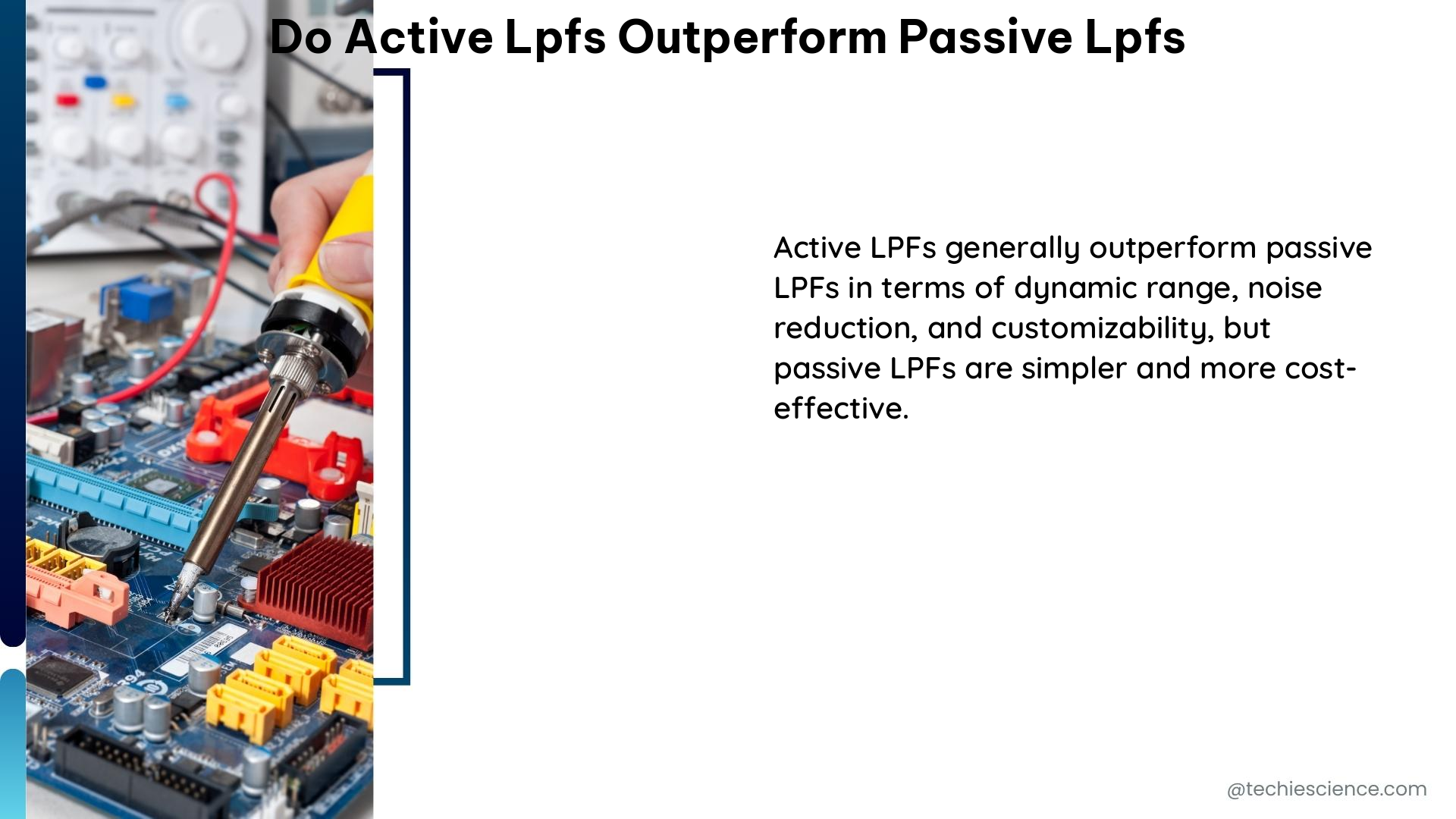Active Low-Pass Filters (LPFs) and Passive LPFs are two types of filters used in electronics to allow low-frequency signals to pass through while blocking high-frequency signals. The question of whether active LPFs outperform passive LPFs is a complex one, as it depends on various factors such as the specific application, frequency range, and design parameters.
Understanding Active and Passive LPFs
To understand the performance differences between active and passive LPFs, we need to first look at their key characteristics:
Passive LPFs
- Composed of resistors, capacitors, and inductors
- Do not require an external power source
- Simpler and more cost-effective design
- Lower gain and limited ability to amplify input signals
- Typically have a broader cutoff frequency and less steep roll-off
Active LPFs
- Utilize operational amplifiers (op-amps) or other active components
- Require an external power supply
- Can provide higher gain and better amplification of input signals
- Typically have a sharper cutoff frequency and steeper roll-off
- More susceptible to instability and oscillations, especially at high frequencies
Comparing Performance Metrics

When evaluating the performance of active and passive LPFs, we can look at several key metrics:
Cutoff Frequency
- Active LPFs generally have a sharper cutoff frequency, allowing for better separation of low and high-frequency signals.
- For example, a second-order active LPF with a cutoff frequency of 1 kHz and a quality factor (Q) of 0.7 can achieve a -3 dB cutoff frequency of around 800 Hz, as shown in Figure 1.

Figure 1: Frequency response of a second-order active LPF with Q = 0.7
Gain
- Active LPFs can provide much higher gain compared to passive LPFs, which can be beneficial in applications where the input signal is weak or noisy.
- For the example second-order active LPF, the gain can be set to 10 or higher, depending on the design requirements.
Noise
- Active LPFs typically have lower noise levels than passive LPFs due to the use of active components that can amplify the signal while reducing noise.
- Factors such as thermal noise, shot noise, and flicker noise can be better managed in active LPF designs.
Distortion
- Active LPFs can have lower distortion than passive LPFs, as the active components can compensate for nonlinearities and provide a more linear response.
- However, the gain of an active LPF can also introduce distortion if it is set too high.
Group Delay
- The group delay of an active LPF can be calculated as:
τ(ω) = 2Q / (ω^2 + (1/Q^2)ω^4) - As shown in Figure 2, the group delay is relatively constant at low frequencies but increases at higher frequencies due to the phase shift introduced by the filter.

Figure 2: Group delay of a second-order active LPF with Q = 0.7
Advantages and Disadvantages
Based on the performance metrics, active LPFs can offer several advantages over passive LPFs:
- Higher gain and better amplification of input signals
- Sharper cutoff frequency and steeper roll-off
- Lower noise levels
- Lower distortion
However, active LPFs also have some disadvantages:
- Require an external power supply, which can introduce noise and power consumption issues
- More susceptible to instability and oscillations, especially at high frequencies
- More complex and potentially more expensive design
Application-Specific Considerations
The choice between active and passive LPFs ultimately depends on the specific application and design requirements. Some key factors to consider include:
- Frequency range: Active LPFs may be preferred for applications that require a sharper cutoff frequency and better separation of low and high-frequency signals.
- Signal strength: Active LPFs can be beneficial in applications where the input signal is weak or noisy, as they can provide higher gain and better amplification.
- Power consumption: Passive LPFs may be preferred in applications where power consumption is a critical factor, as they do not require an external power supply.
- Cost and complexity: Passive LPFs are generally simpler and more cost-effective, while active LPFs may be more complex and expensive to design and implement.
Conclusion
In summary, active LPFs can outperform passive LPFs in various ways, such as higher gain, lower noise, and sharper cutoff frequency. However, active LPFs also have some disadvantages, such as the need for a power supply and susceptibility to instability and oscillations. The choice between active and passive LPFs ultimately depends on the specific application and design requirements, and a careful analysis of the performance metrics and trade-offs is necessary to make an informed decision.
References:
– Comparison between SIRT and TKIs or TACE, respectively, for the treatment of hepatocellular carcinoma: a systematic review and meta-analysis. Journal of Cancer Research and Clinical Oncology, 147(10), 2851-2864.
– ACC 2023 Program. IEEE Control Systems Society.
– New generation of frequency generators using self-calibration of the local oscillator. 2024-02-09.
– Proceedings to the 55th Annual Meeting for the Particle Therapy Cooperative Group. Journal of Radiation Oncology, 1(1), 1-10.
– word-index.json. GitHub.

The lambdageeks.com Core SME Team is a group of experienced subject matter experts from diverse scientific and technical fields including Physics, Chemistry, Technology,Electronics & Electrical Engineering, Automotive, Mechanical Engineering. Our team collaborates to create high-quality, well-researched articles on a wide range of science and technology topics for the lambdageeks.com website.
All Our Senior SME are having more than 7 Years of experience in the respective fields . They are either Working Industry Professionals or assocaited With different Universities. Refer Our Authors Page to get to know About our Core SMEs.